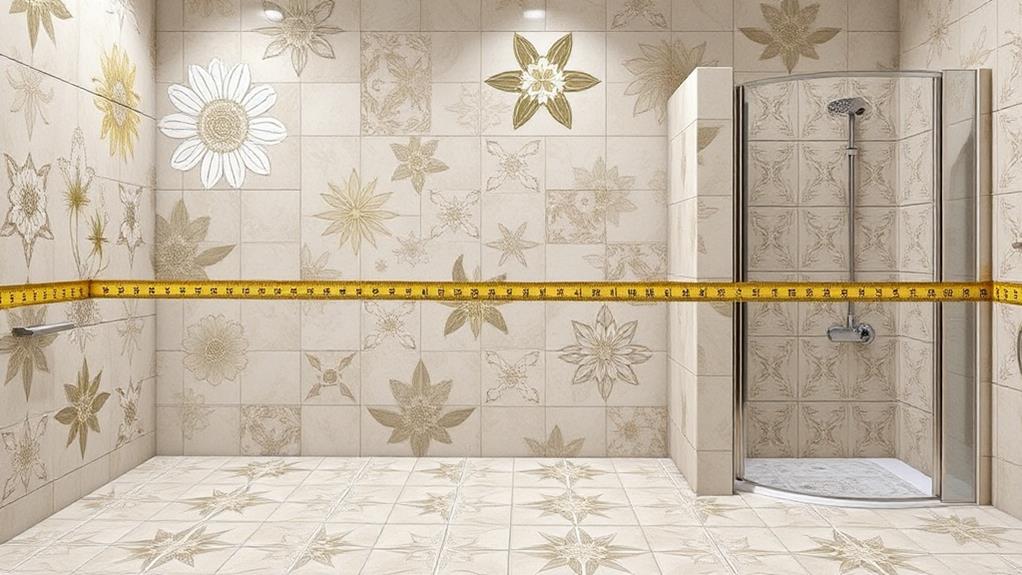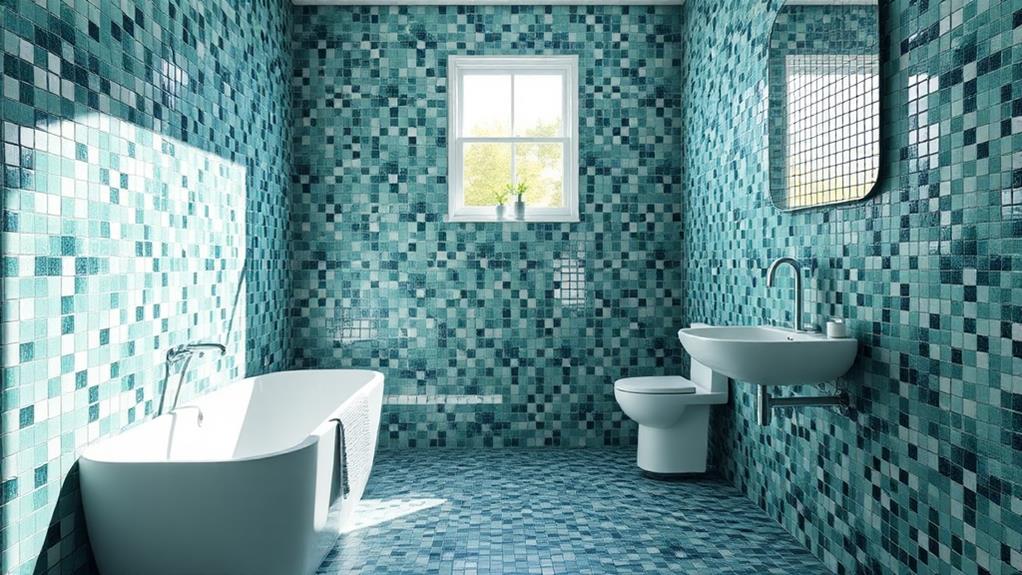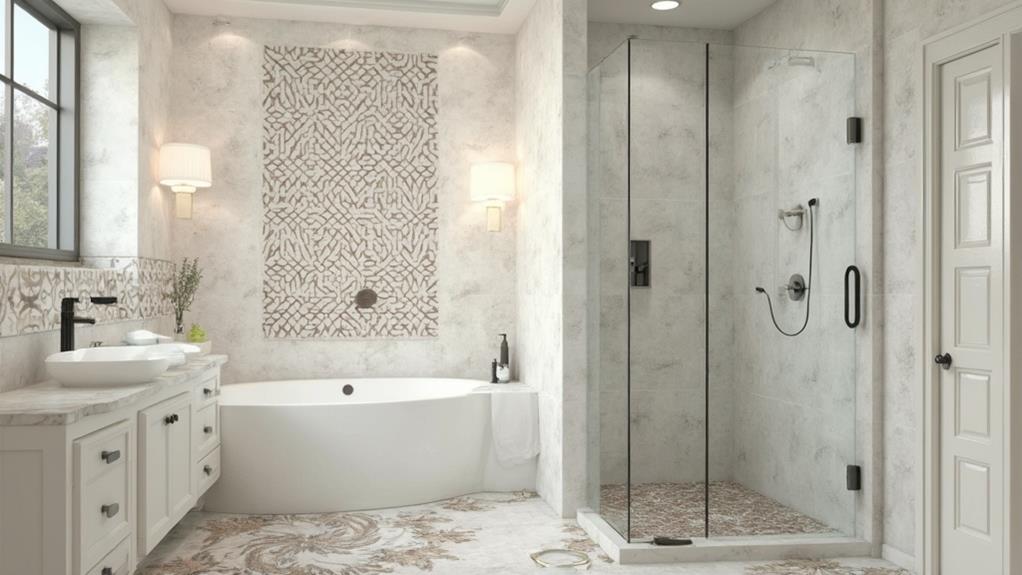When choosing patterns for your bathroom, scale is crucial. For small bathrooms, opt for smaller-scale patterns to avoid overwhelming the space. Use vertical patterns to create the illusion of height and consider light, neutral tones to maintain a sense of openness. In larger bathrooms, you can embrace bold, large-scale patterns and even mix different scales for a sophisticated look. Balance is key – limit yourself to no more than three distinct patterns and choose a dominant one as the focal point. Consider the impact of color on pattern perception and strategically place patterns to define zones. By mastering these principles, you'll unlock the full potential of your bathroom's design.
Understanding Pattern Scale Basics

Scale is the key to successful pattern use in bathrooms. When choosing patterns for your bathroom, it's essential to understand how scale affects the overall look and feel of the space. Large-scale patterns feature bold, oversized designs that make a statement and can visually expand a small bathroom. On the other hand, small-scale patterns have intricate, detailed elements that can add depth and interest without overwhelming the space.
Consider the size of your bathroom when selecting pattern scales. In larger bathrooms, you can experiment with a mix of scales, using large patterns on feature walls or floors and complementing them with smaller patterns on accessories or textiles. For smaller bathrooms, stick to one dominant scale to avoid visual clutter. Medium-scale patterns offer a versatile option that works well in most bathroom sizes.
Remember that the viewing distance also impacts pattern perception. Patterns on floors or lower walls may appear smaller from a standing position, while those on upper walls or ceilings can seem larger. By understanding these basics, you'll be better equipped to choose patterns that enhance your bathroom's aesthetics and create a harmonious design.
Small Bathroom Pattern Strategies
Cleverly incorporating patterns into small bathrooms can make a big impact. When working with limited space, you'll want to use patterns strategically to create the illusion of a larger area. Opt for smaller-scale patterns that don't overwhelm the room. Tiny geometric prints, delicate florals, or subtle textures work well in compact spaces.
Consider using patterns vertically to draw the eye upward and create a sense of height. Vertical stripes on wallpaper or tiles can make your ceiling appear higher. Alternatively, use patterns on a single accent wall to add interest without crowding the space.
In small bathrooms, it's crucial to maintain a cohesive color scheme. Choose patterns that complement your existing palette and stick to a limited color range. Light, neutral tones can help open up the space, while bold accents can add personality.
Don't forget about the floor – a patterned tile can add depth and dimension to a small bathroom. Just be sure to balance it with simpler elements elsewhere in the room. Remember, less is often more in compact spaces, so use patterns judiciously to create a harmonious and visually appealing bathroom.
Large Bathroom Pattern Approaches

Spacious bathrooms offer a luxurious canvas for bold pattern choices. You can embrace large-scale patterns that might overwhelm smaller spaces. Consider oversized floral prints, geometric shapes, or dramatic marble veining for walls or floors. These patterns can create a stunning focal point and add depth to your expansive bathroom.
Don't shy away from mixing patterns in a large bathroom. You can combine different scales and styles to create a layered, sophisticated look. For example, pair a large-scale wallpaper with smaller patterned floor tiles or textured shower curtains. Just ensure there's a unifying element, like color or theme, to tie everything together.
In a spacious bathroom, you've got room to play with three-dimensional patterns too. Think about incorporating patterned tiles that create texture and visual interest, such as raised geometric designs or intricate mosaics. You can also use patterns to define different zones within the bathroom, like a patterned accent wall behind the bathtub or a bold floor design in the shower area.
Balancing Multiple Patterns
The art of balancing multiple patterns in a bathroom requires a delicate touch. When combining different patterns, it's crucial to maintain a sense of harmony while avoiding visual chaos.
Start by choosing a dominant pattern that will serve as the focal point. This could be a bold wallpaper, patterned tiles, or an eye-catching shower curtain.
Next, select secondary patterns that complement the main one. These should be smaller in scale and less visually demanding. Consider using a mix of geometric and organic patterns to create contrast and interest. Stick to a cohesive color palette to tie the different patterns together.
Remember the rule of three: limit yourself to no more than three distinct patterns in the space. This will prevent the bathroom from feeling overwhelming. Use solid colors or neutral elements to break up the patterns and provide visual rest.
Consider the scale of each pattern in relation to the room's size. Larger patterns work well in spacious bathrooms, while smaller patterns are better suited for cozier spaces. Don't forget to balance pattern placement throughout the room, ensuring an even distribution of visual interest.
Color Impact on Pattern Perception

When selecting patterns for your bathroom, color plays a significant role in how those patterns are perceived. Light colors can make patterns appear more subtle and spacious, while dark colors intensify patterns and may make a space feel smaller. You'll want to consider how the color of your chosen pattern interacts with the overall bathroom size and lighting.
In smaller bathrooms, opt for lighter-colored patterns to create an illusion of more space. Pale blues, soft greens, and light grays can open up the room while still adding visual interest.
For larger bathrooms, you have more flexibility to experiment with bolder, darker-colored patterns that can add depth and drama.
Remember that color contrast within the pattern itself also affects perception. High-contrast patterns, regardless of their overall color, tend to appear more prominent and can overwhelm a small space. Low-contrast patterns, on the other hand, blend more seamlessly into the background and can be a great choice for smaller bathrooms or when you want a more subtle effect. Always consider the interplay between pattern scale, color, and contrast to achieve the desired visual impact in your bathroom.
Practical Pattern Application Tips
Armed with knowledge about pattern scale and color impact, you're ready to apply patterns practically in your bathroom. Start by selecting a focal point, such as a feature wall or floor, to showcase your chosen pattern. This approach prevents overwhelming the space and creates visual interest.
Consider using larger patterns on walls and smaller, complementary patterns on floors or accessories. This hierarchy helps guide the eye and maintains balance. When mixing patterns, stick to a cohesive color palette to ensure harmony.
For small bathrooms, use patterns sparingly. Opt for one bold pattern as a statement piece, paired with solid colors or subtle textures elsewhere. In larger bathrooms, you can be more adventurous, combining multiple patterns of varying scales.
Don't forget about lighting. Natural and artificial light can significantly affect pattern perception, so test samples in your bathroom's lighting conditions before committing.
Lastly, consider the longevity of your chosen patterns. While trendy designs can be exciting, classic patterns tend to have more staying power. If you're unsure, start with patterned accessories or easily replaceable elements like shower curtains or bath mats to experiment with different styles.
Conclusion
You're now armed with the know-how to make your bathroom sing with perfectly scaled patterns. Like a conductor leading an orchestra, you'll orchestrate small, medium, and large prints into a harmonious ensemble. Remember, 75% of designers agree that scale can make or break a room's aesthetic. So go ahead, play with patterns, and transform your bathroom from a simple space into a visual symphony that'll leave guests in awe.

